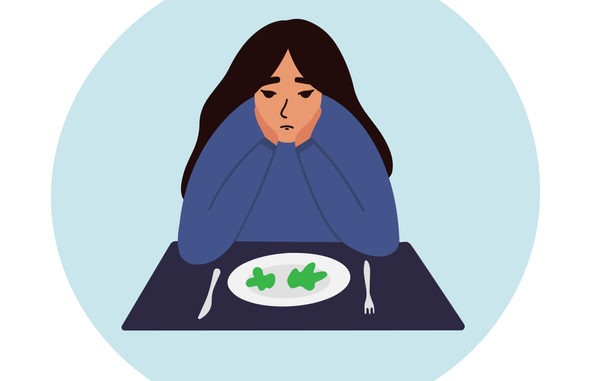
A spike in people seeking treatment for eating disorders during the COVID-19 pandemic has revealed their global nature and severity. Jane Feinmann reports from the International Conference on Eating Disorders
This is an edited version of an article that originally appeared on The BMJ
New research presented at the conference—attended by researchers, clinicians, and experts with lived experience from 56 countries—showed why previously healthy adolescents succumbed during the pandemic.
In normal times, more than half of eating disorders begin during a particular time window in adolescence when peer-to-peer social comparison is an essential part of the development of body image, self-esteem, and social cognition, said Angela Favaro, head of the Department of Neuroscience at the Padova Neuroscience Centre in Italy. ‘Social avoidance’ as well as inflexible thinking and negative emotions are key predictors in early onset eating disorders, she told the conference. Lockdowns and school closures have enforced social avoidance, leaving children “exposed to an absence of peer-to-peer social comparison at a crucial time in their development.”
Stefan Ehrlich, professor of psychological and social medicine at the Technical University of Dresden, said research has shown food restriction can lead to resistance to ghrelin, the ‘hungry hormone’ produced by the gut that prompts people to seek food—a process “reinforced when adolescents are isolated from their peers.”
In India, where one-in-four adolescent girls, and one–in-five boys, are estimated to have ‘disturbed eating habits and behaviours’, many of these suffered “increased anxiety as they came under constant supervision when families return to their villages, living in cramped conditions,” paediatrician Kritika Malhotra of Jawaharlal Nehru Medical College told the conference.
Teens, adults, and doctors too
Adults have also presented with eating disorders in record numbers during the pandemic—the conference heard reports of binge eating and purgative behaviour from Argentina and Lebanon.
A contributing factor, according to Jennifer Couturier of McMaster Children’s Hospital in Ontario, Canada, was “the bombardment of social media posts and messages about ‘inevitable’ weight gain related to staying at home.”
“It seems likely that exposure to the stress of the pandemic has pushed over the line those with an average genetic risk for an eating disorder that they might otherwise never have expressed,” Cynthia Bulik, Distinguished Professor of Eating Disorders at the University of North Carolina, told The BMJ.
Healthcare professionals are vulnerable to maladaptive eating behaviours, Mohsen Khosravi, from the University of Medical Sciences, Zahedan, Iran, said. “We know that negative emotions – including anxiety, stress, depression, and anger – trigger disordered eating behaviours,” Khosravi told The BMJ. “For healthcare professionals, the lack of medical equipment in the current crisis is accompanied by the intensification of negative emotions, triggering disordered eating.”
Paulo Machado, head of the Eating Disorders Research Group at the University of Minho University in Portugal, told the conference that many with an existing diagnosis experienced a “worsening of their condition, especially if associated with difficulties in emotion regulation.”
Embracing technology
Online consultations, widely introduced during the pandemic, have proved an unexpected hit, however. While more than half of surveyed patients with an eating disorder in the Netherlands and the US complained that their treatment had deteriorated when interviewed at the beginning of the pandemic, a follow-up study, to be published soon, showed that fewer than one-in-four felt the same in May 2021.
“Presumably, in that time, practitioners and patients have become more familiar with the technology,” lead researcher Christine Peat, assistant professor of psychiatry at the UNC, told the conference.
Portuguese patients regarded online services as ‘‘a lesser form of treatment when our clinic first stopped in-person consultations,” said Machado, but now the clinic is open and many prefer to stay online, he said. In Israel, ultra-orthodox families, who mostly avoid technology, including the internet, “are allowing their daughters to participate in online clinics they wouldn’t want them to attend in person.”
The rise led to the first guidelines on virtual care of eating disorders in children, adolescents and emerging adults, published in April 2021 and produced by a Canadian consensus panel as part of a project funded by the Canadian Institutes of Health Research. Couturier, lead author of the guidelines, acknowledged they were based on the small amount of available evidence, but said the need for guidance was acute given that “the eating disorder population is particularly vulnerable and at significant risk of death should they not receive appropriate care.”
Treatment questions
Couturier’s team also identified noticeable gaps in knowledge, notably around the role of virtual care in more intensive services such as virtual day hospitals. It echoes a demand for more research and funding from leading global specialists, made in Lancet Psychiatry in February.
Stephen Touyz, professor of clinical psychology at the University of Sydney, told the conference that new treatments should incorporate the “wonderfully innovative technologies that are currently transforming healthcare.
“The virtual reality sector has made spectacular advances and could now assist with body shape over-evaluation. Smartwatches that already allow live electrocardiogram data to be recorded could be developed to enable live streaming feedback at meal times, one of the greatest challenges for patients with eating disorders,” he told The BMJ. These could lead to better treatments that also take account of new findings in brain dynamics and genetics in eating disorders.
The need is urgent, says Khosravi. There is concern—based on evidence from previous global health disasters—that this pandemic will worsen the severity of symptoms of eating disorders. Recognising the global nature of these disorders, and the impact of the pandemic, is a start.

Be the first to comment